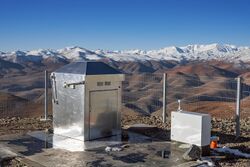MASCARA
Topic: Astronomy
 From HandWiki - Reading time: 4 min
From HandWiki - Reading time: 4 min
MASCARA (Multi-site All-Sky CAmeRA) is an exoplanet experiment by Leiden University. It has two stations, one in each hemisphere, each of which use cameras to make short exposure photographs of most of the visible sky[1] to observe stars to a magnitude of 8.4.[2] The Northern Hemisphere station at Roque de los Muchachos Observatory, La Palma, started observations in February 2015. The Southern Hemisphere station at La Silla Observatory, Chile, saw first light in July 2017.[3]
MASCARA-1b
On 17 July 2017, the discovery of MASCARA-1b, a confirmed superjovian exoplanet with a mass 3.7MJ, was reported by the survey team. MASCARA-1b is a hot Jupiter transiting its parent A-type star; its orbit is misaligned with the star's rotation.[4] The planet was found unusually reflective for hot Jupiter with the measured geometric albedo of 0.171+0.066−0.068 and dayside temperature of 3062+66−68 K.[5] Attempts to spectroscopically characterize its composition were failing as in 2022 due to relatively high planetary surface gravity resulting in compact atmosphere.[6]
MASCARA-2b
A second planet, MASCARA-2b, also known as KELT-20b, was also announced in 2017. It is a hot Jupiter orbiting an A-type star.[7] The carbon monoxide, steam[8][9] and neutral iron[10] detection in the atmosphere of MASCARA-2b was announced in 2022.
MASCARA-4b
A planet MASCARA-4b (also known as HD 85628 Ab) discovery was announced in 2019. It is a hot Jupiter on retrograde and slightly eccentric orbit.[11] The planet is unusually reflective for a hot Jupiter.[12] Hydrogen, sodium, magnesium, calcium and iron emission from planetary atmosphere was detected.[13]
MASCARA-5b
In 2021, a planet MASCARA-5b (more commonly known as TOI-1431 b), is an Ultra-hot Jupiter. Its dayside temperature is 2,700 K (2,427 °C), making it hotter than 40% of stars in our galaxy.[14] The nightside temperature is 2,600 K (2,300 °C).[15]
List of discovered exoplanets
| Star | Constellation | Right ascension |
Declination | App. mag. |
Distance (ly) | Spectral type |
Planet | Mass (MJ) |
Radius (RJ) |
Orbital period (d) |
Semimajor axis (AU) |
Orbital eccentricity |
Inclination (°) |
Discovery year |
|---|---|---|---|---|---|---|---|---|---|---|---|---|---|---|
| MASCARA-1 | Equuleus | 21h 10m 12.4s | +10° 44′ 20″ | 8.3 | 188.7 | A8 | b | 3.7 | 1.5 | 2.14878 | 0.043 | 0 | 87 | 2017 |
| MASCARA-2 | Cygnus | 19h 38m 38.7s | +31° 13′ 09″ | 7.58 | 137 | A2V | b | 3.518 | 1.83 | 3.4741085 | 0.0542 | 0.0 | 86.2 | 2017 |
| MASCARA-3 | Ursa Major | 10h 47m 38s | +71° 39′ 21″ | 8.4 | 96.79 | F5 | b | 5.18 | 1.272 | 5.5514926 | 0.06971 | 89.16 | 83.11 | 2019 |
| MASCARA-4 | Carina | 09h 50m 19.2s | −66° 06′ 50″ | 86.7 | 171.54 | A3V | b | 3.1 | 1.53 | 2.82406 | 0.047 | 0 | 88.81 | 2019 |
| MASCARA-5 | Cepheus | 21h 04m 49s | +55° 35′ 17″ | 8 | 149.6 | AmC | b | 3.14 | 1.508 | 2.65022 | 0.047 | 0.01 | 80.4 | 2021 |
References
- ↑ "Multi-site All-Sky CAmeRA – Official Website". Leiden Astronomy MASCARA group. http://mascara1.strw.leidenuniv.nl/. Retrieved 26 July 2017.
- ↑ "Eyes Wide Open for MASCARA in Chile – Exoplanet hunter sees first light at ESO's La Silla Observatory". European Southern Observatory. http://www.eso.org/public/unitedkingdom/teles-instr/lasilla/mascara/. Retrieved 26 July 2017.
- ↑ "Eyes Wide Open for MASCARA in Chile – Exoplanet hunter sees first light at ESO's La Silla Observatory". European Southern Observatory. 19 July 2017. http://www.eso.org/public/news/eso1722/. Retrieved 26 July 2017.
- ↑ Talens, G. J. J et al. (2017). "MASCARA-1 b. A hot Jupiter transiting a bright mV = 8.3 A-star in a misaligned orbit". Astronomy & Astrophysics 606: A73. doi:10.1051/0004-6361/201731282. Bibcode: 2017A&A...606A..73T.
- ↑ Spi-OPS:Spitzer and CHEOPS confirm the near-polar orbit of MASCARA-1b and reveal a hint of dayside reflection, 2021
- ↑ Transmission spectroscopy of MASCARA-1b with ESPRESSO:Challenges of overlapping orbital and Doppler tracks, 2022
- ↑ Talens, G. J. J et al. (2018). "MASCARA-2 b: A hot Jupiter transiting a mV = 7.6 A-star". Astronomy & Astrophysics A57: 612. doi:10.1051/0004-6361/201731512. Bibcode: 2018A&A...612A..57T.
- ↑ Strong H2O and CO emission features in the spectrum of KELT-20b driven by stellar UV irradiation, 2022
- ↑ Unifying High- and Low-resolution Observations to Constrain the Dayside Atmosphere of KELT-20b/MASCARA-2b, 2022
- ↑ Detection of iron emission lines and a temperature inversion on the dayside of the ultra-hot Jupiter KELT-20b, 2022
- ↑ MASCARA-4 b/bRing-1 b - A retrograde hot Jupiter around the bright A3V star HD 85628, 2019
- ↑ Gravity-Darkening Analysis of Misaligned Hot Jupiter MASCARA-4 b, 2019
- ↑ Transmission spectroscopy of the ultra-hot Jupiter MASCARA-4 b Disentangling the hydrostatic and exospheric regimes of ultra-hot Jupiters, 2022
- ↑ "Scientists uncover a 'hellish' planet so hot it could vaporize most metals". CNET. April 27, 2021. https://www.cnet.com/news/scientists-uncover-a-hellish-planet-so-hot-it-could-vaporize-most-metals/. Retrieved April 27, 2021.
- ↑ "'Hellish' new planet discovered". University of Southern Queensland. April 27, 2021. https://www.usq.edu.au/news/2021/04/hellish-new-planet. Retrieved April 27, 2021.
Papers
- G.J.J. Talens et al., The Multi-site All-Sky CAmeRA: Finding transiting exoplanets around bright (mV < 8) stars, accepted for publication in A&A arXiv:1702.03931
External links
- MASCARA website at Leiden University
- MASCARA, ESO
 |
14 views | Status: cached on October 14 2024 17:54:55
↧ Download this article as ZWI file
 KSF
KSF


